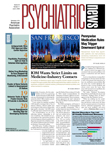How does stress affect the physiology of memory? The current consensus contains a contradiction.
“The classic explanation says that stress activates the amygdala and inhibits the hippocampus, despite the accepted view that the hippocampus is involved in the formation of new memories,” said David Diamond, Ph.D., a professor of psychology and director of the Center for Preclinical and Clinical Research on Post-Traumatic Stress Disorder at the University of South Florida in Tampa.
Diamond spoke at the fourth annual Conference on the Neurobiology of Amygdala and Stress, held in April at the Uniformed Services University of the Health Sciences in Bethesda, Md.
Research now suggests that a new model may be in order, he said.
Diamond induced stress in rats by placing them inside clear plastic boxes and letting cats loose to poke at the outside of the boxes, not harming the rats physically but certainly scaring them. Rats thus stressed evidenced a complete suppression of neuronal plasticity in the hippocampus and made more memory errors later during tests.
In water-maze tests, for instance, stressed rats initially learned the task as well as their unstressed peers but performed worse 30 minutes later on memory tests. Stress interfered with hippocampal memory by reducing production of calmodulin kinase II, which is involved in synaptic plasticity.
There was no activation of the amygdala in unstressed rats, while stressed animals showed enhanced amygdala function. To test whether the amygdala is necessary to impair hippocampal memory function, Diamond chemically impaired the amygdala, blocking the negative effects of stress. These rats learned tasks as well as the untreated animals but couldn't store memories and couldn't retrieve them 24 hours later.
Since retrieval is based on structural changes, Diamond's graduate students counted the spines on neuronal dendrites in the hippocampus. There was a significant increase in the number of spines in trained, unstressed rats, but not in the number in those trained and stressed. Even if the latter learned normally, they didn't make spines, and they created no long-term memories.
“So, in a frightening situation, you have the activation of the amygdala and the inhibition of the hippocampus,” he said. “If shock inhibits hippocampal function, why does the rat remember the event?”
And why are traumatic memories so powerful? The answer is twofold, he said. For one thing, findings contrary to the consensus have been ignored, but timing is also important.
Stress comes in two waves, he said. First, there is what he calls“ flashbulb memory,” activated and processed by the amygdala and the hippocampus in seconds to minutes. Circuits between the amygdala and the hippocampus are strengthened for a short time. The hippocampus is flooded with neuromodulators—norepinephrine, CRF, ACTH, cortisol, dopamine, acetylcholine, and others—which increase postsynaptic Ca+ and enhance memory.
“Somehow the hippocampus makes sense of all those modulators,” he marveled.
But then the second phase kicks in, running from minutes to hours to days. NMDA receptor sensitivity declines. The hippocampus is in a refractory state and won't consolidate memory.
This combination may help explain how traumatic, emotion-laden events can produce both powerful memories and stress-induced amnesia, he said.
Giving the rats a brief, two-minute stress and training them 30 minutes afterward again produced no long-term memory, indicating that they had moved into the second phase by the time training began. Stressing the rats immediately before training, however, produced better results at 24 hours.
In this temporal dynamics model, trauma induces synchronous activation of the amygdala and the hippocampus in the first phase and continued activation of the amygdala and suppression of hippocampal plasticity in the second phase.
Future clinical developments will need to take this model into account.
“Successful extinction treatment must reduce amygdala activation and hippocampal suppression,” he said. ▪

